|
|
|
Sort Order |
|
|
|
Items / Page
|
|
|
|
|
|
|
| Srl | Item |
| 1 |
ID:
142582
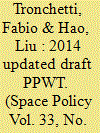

|
|
|
|
|
| Summary/Abstract |
On June 10, 2014, Russia and China presented the updated Draft Treaty on the Prevention of the Placement of Weapons in Space, the Threat or Use of Force Against Space Objects (PPWT) to the Conference on Disarmament. The original 2008 Draft PPWT had been poorly received and criticized, inter alia, for not addressing the most pressing threats to space objects, strategically favoring the interests of its co-sponsors and lacking reliable means of verification.
In presenting the 2014 update the Russian and Chinese representatives pointed out that it had been drafted by taking into account the criticism leveled to its 2008 version and that it should be now viewed as an international effort rather than as a mere Chinese and Russian initiative: they also added that for this reason the amended Draft PPWT constituted a solid instrument to enhance the security of space objects and stood a higher chance of success than its predecessor.
It is, thus worth wondering whether the positive attitude and high expectations of China and Russia towards the amended Draft should be shared or rejected (counteracted, opposed). The present paper gives a rather negative answer to this question. While proceeding to a substantial re-wording and re-organization of its text, the amended Draft maintains the most controversial and debatable aspects of its 2008 version. Therefore, it seems unlikely that delegations within the CD might support it.
Despite its overall negative assessment, the present paper argues that the submission of 2014 updated Draft PPWT may positively contribute, at least indirectly, to the security of space objects. The likely failure of the amended draft could be used by the CD members as an opportunity to focus their efforts in putting in place legal barriers to selected threats to space objects, such as the testing of destructive, debris-generating, ASAT devices. There are elements to believe that a ban on destructive ASAT tests could be achieved and acceptable by the majority of States.
|
|
|
|
|
|
|
|
|
|
|
|
|
|
|
|
| 2 |
ID:
131718
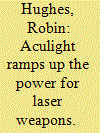

|
|
|
|
|
| Publication |
2014.
|
| Summary/Abstract |
The US army's drive toward a benchmark 100KW class mobile laser combat weapon system edged a step closer with the space and missile defence command (SMDC) award of a contract to Lockheed Martin for the development and manufacture of a 60KW high energy laser (HEL) effector.
|
|
|
|
|
|
|
|
|
|
|
|
|
|
|
|
| 3 |
ID:
101224
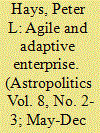

|
|
|
| 4 |
ID:
126371
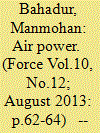

|
|
|
|
|
| Publication |
2012.
|
| Summary/Abstract |
The Indian Air Force (IAF) is into its eighth decade and as it closes in on its centenary, a mere two decades away, many a treatise has been propounded on the challenges ahead for the youngest armed service of independent India. What started as a mere flight of Wapitis at Drigh Road, Karachi, has grown into a potent power projection arm of the state.
The IAF derives its fortitude from its motto, Nabha Sparsham Deeptam (Touch the Sky with Glory). But there is perhaps a limitation in the coining of this motto as there is a hint of conclusiveness in the envelope of operation of Air Power. A more intuitive and farsighted approach may well have resulted in its coining to include space, the final frontier. But is space the final frontier? One better be careful lest a scribe writing about the IAF a few decades from now also questions this writer's perceptive ability!
Limiting the horizon to a manageable timeframe makes the future 'realistically' transparent. So, considering a timespan of 20 years, when the IAF turns 100, let's evaluate how the anticipated threats and challenges are to be addressed based on the IAF doctrine.
|
|
|
|
|
|
|
|
|
|
|
|
|
|
|
|
| 5 |
ID:
130046
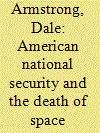

|
|
|
|
|
| Publication |
2014.
|
| Summary/Abstract |
At the beginning of the space age, the United States relied upon the general acceptance of a sanctuary narrative of outer space in order to help support its reconnaissance activities over the Soviet Union. The notion that space could be a sanctuary thus served as a diplomatic tactic, one designed to thwart Soviet opposition to American overflight. While the Soviets eventually achieved parity-having later acquired the ability to surveil the United States-the notion of sanctuary became untenable once the Soviet Union began to further leverage space power for the aim of attacking American satellites and naval assets. The crucial moment, as revealed in recently declassified documents, occurred in 1976 when the Ford Administration recognized the need for an American anti-satellite capability. Subsequently, while the Carter Administration appeared to pursue comprehensive space arms control, what was really in play was a gambit, one designed to eliminate the Soviet's co-orbital anti-satellite capability and maintain strategic parity in space.
|
|
|
|
|
|
|
|
|
|
|
|
|
|
|
|
| 6 |
ID:
193568
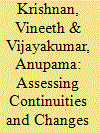

|
|
|
|
|
| Summary/Abstract |
Japan announced its new space security blueprint in June 2023. The new blueprint lays down a ten-year roadmap for the country to enhance the utilization of space for its military. While the announcement has been widely perceived as a ‘first’, it is in fact a crystallization of Japan’s space security strategies over the last few decades. This article interprets the blueprint in light of Japan’s counterstrike doctrine. It traces Japan’s rise as a military space power since the 1970s and analyses its evolving approach to space security. Continuities and changes in the 2023 blueprint are assessed against Japan’s historic policies.
|
|
|
|
|
|
|
|
|
|
|
|
|
|
|
|
| 7 |
ID:
089864
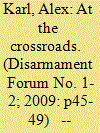

|
|
|
|
|
| Publication |
2009.
|
| Summary/Abstract |
In 1967, when the space age was still in its infancy, the Outer Space Treaty entered into force with the aim to protect the common interest of all societies while regulating the competition for military advantage that dominated the pioneering space programmes of the United States and the Soviet Union. The treaty was amended four times in the following 12 years with the introduction of the Rescue Agreement, the Liability Convention, the Registration Convention and the Moon Agreement.
|
|
|
|
|
|
|
|
|
|
|
|
|
|
|
|
| 8 |
ID:
132831
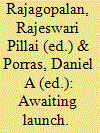

|
|
|
|
|
| Publication |
New Delhi, Observer Research Foundation,
|
| Description |
275p.Pbk
|
|
|
|
|
|
|
|
|
|
|
|
Copies: C:1/I:0,R:0,Q:0
Circulation
| Accession# | Call# | Current Location | Status | Policy | Location |
| 057859 | 358.8/RAJ 057859 | Main | On Shelf | General | |
|
|
|
|
| 9 |
ID:
114245
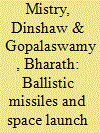

|
|
|
|
|
| Publication |
2012.
|
| Summary/Abstract |
International security concerns about ballistic missile proliferation have frequently highlighted the links between ballistic missiles and space launch vehicles. This article examines the extent of these links through a comprehensive survey of ballistic missile and space rocket programs in regional powers. It notes that missiles were derived from existing space launchers in just a small fraction of these cases. In a slightly greater fraction, space launchers were drawn from existing missile programs. This analysis suggests that though security concerns about space launchers being used as ballistic missiles are valid, the reverse trend, that of ballistic missiles being used as space launch vehicles, cannot be ignored. At the same time, as long as regional powers are limited to short-range and medium-range systems, their missile and space projects would only raise limited missile proliferation and space security concerns.
|
|
|
|
|
|
|
|
|
|
|
|
|
|
|
|
| 10 |
ID:
126468
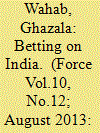

|
|
|
|
|
| Publication |
2012.
|
| Summary/Abstract |
Boeing has a long history in India, beginning with its 707 commercial jetliner that was acquired by Air India in 1960. The wait for successful military orders took much longer, but Boeing has done its homework well to come out on top for important contracts for the Indian Air Force (IAF) and Indian Navy (IN). Importantly for Boeing, the orders all have the potential for repeat orders, ensuring that Boeing will be busy well into the next decade. Boeing's success in the Indian market is also a huge opportunity for Indian aerospace and software companies as Boeing purchases goods and services from more than 23,000 suppliers across the world worth more than USD 50 billion each year. The company's global supply chain contributes more than 60 per cent of the value of its products. Boeing delivered 601 commercial airplanes and supported the delivery of 144 production military aircraft in 2012!
|
|
|
|
|
|
|
|
|
|
|
|
|
|
|
|
| 11 |
ID:
130045
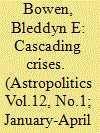

|
|
|
|
|
| Publication |
2014.
|
| Summary/Abstract |
The term space security is often used, but seldom analyzed. This is a significant gap in the literature of space politics, as it posits considerable implications for debates on how to deal with a runaway growth in the space debris population, and how we argue for or against space weaponization. Securitizing all threats in space may lead to greater difficulties in enacting debris removal measures, as these systems are inherently dual-use. A case is made for keeping space security in its traditional connotations of national security so that environmental issues related to orbital debris can be resolved with reduced security concerns in a space development framing.
|
|
|
|
|
|
|
|
|
|
|
|
|
|
|
|
| 12 |
ID:
079810
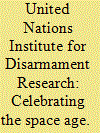

|
|
|
|
|
| Publication |
Geneva, UNIDIR, 2007.
|
| Description |
xx, 226p.
|
| Standard Number |
9789290451891
|
|
|
|
|
|
|
|
|
|
|
|
Copies: C:1/I:0,R:0,Q:0
Circulation
| Accession# | Call# | Current Location | Status | Policy | Location |
| 052776 | 358.8/UNI 052776 | Main | On Shelf | General | |
|
|
|
|
| 13 |
ID:
142580
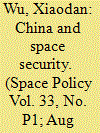

|
|
|
|
|
| Summary/Abstract |
There is an obvious gap between China's express intention to be a responsible space actor and the perception of its being a possible or imminent threat to space security. This article identifies the elements leading to the false perception held by some States based on an evaluation of China's space-related controversial events: the ideological and military considerations; the misunderstanding and obscurity surrounding China's space policies and activities; the inaccurate contention of China's non-compliance with its international legal obligations and its lack of expertise and experience in international negotiations. Based on the historical opportunities that the China's current government is facing, the conclusion will be reached at how to bridge this gap through transparency improvement and the establishment of confidence-building measures, including the elimination of military involvement and encouraging commercial exploration and utilization of outer space through national legislation; the improvement of the space governance mechanisms; more effective, targeted and meaningful information exchange and policy dialogue to enlarge cooperation and forge strategic military trust.
|
|
|
|
|
|
|
|
|
|
|
|
|
|
|
|
| 14 |
ID:
130177
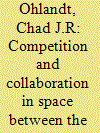

|
|
|
|
|
| Publication |
2014.
|
| Summary/Abstract |
U.S. national security space policy has recently shifted significantly toward increased international cooperation. Australian space activities have been reinvigorated, but remain underfunded. China's space activities remain vigorous, but largely unilateral. Given U.S. policy changes, opportunities for cooperation and collaboration among all three have improved.
|
|
|
|
|
|
|
|
|
|
|
|
|
|
|
|
| 15 |
ID:
179861
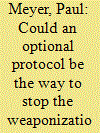

|
|
|
|
|
| Summary/Abstract |
Since the early 1980s, the United Nations General Assembly and its affiliated forum, the Conference on Disarmament in Geneva, has had the Prevention of an Arms Race in Outer Space issue on its agenda. In the intervening years, the threat of weapons being introduced into the outer space realm has waxed and waned, but, in the main, a benign environment free from man-made threats has prevailed, allowing for great strides in the exploration and use of space. Recently, a renewal of great power rivalry including the development of offensive “counter-space” capabilities has resurrected the spectre of armed conflict in space. With widespread political support for the non-weaponization of outer space, has the time come to give legal expression to this goal by means of an optional protocol to the 1967 Outer Space Treaty?
|
|
|
|
|
|
|
|
|
|
|
|
|
|
|
|
| 16 |
ID:
132721


|
|
|
|
|
| Publication |
2014.
|
| Summary/Abstract |
space systems play an important role in sustaining the development, prosperity and security of many nations. As more nations become critically reliant on space systems, questions of maintaining safety and strategic stability in outer space have come to the fore. Transparency and Confidence-Building Measures (TCBMs) for outer space activities have an important role to play in providing clarity about the intentions of States and in articulating norms of behaviour in outer space. TCBMs take several forms. They may be the elaboration of basic principles related to the exploration and use of outer space, political measures related to establishing norms of conduct, information-sharing activities to improve the transparency of outer space activities, operational practices which demonstrate a commitment to mutual cooperation in outer space, or consultative mechanisms. We present an analytical framework for evaluating potential TCBMs and illustrate the application of this framework to examples of potential operational, regulatory, treaty-based and declaratory TCBMs.
|
|
|
|
|
|
|
|
|
|
|
|
|
|
|
|
| 17 |
ID:
152071
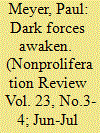

|
|
|
|
|
| Summary/Abstract |
International cooperation on outer-space security has fluctuated over the past decades, marked by periods of common endeavor and relative stability as well as times of destabilizing developments and rising tensions. A high-water mark of space-security diplomacy was the 2013 UN Group of Governmental Experts consensus report on “Transparency and Confidence-Building Measures in Outer Space Activities,” which set out a rich menu of measures and promised new levels of cooperative security among states. Regrettably, the report was followed by a series of negative developments that threaten to reverse the cooperative trend it espoused. These developments include the introduction (by Russia and China) and rejection (by the United States) of a revised draft treaty on the Prevention of Placement of Weapons in Outer Space (PPWT); the adoption by the UN General Assembly of a divisive resolution on “no first placement” of space weapons; the failure of the European Union to gain support for its proposed Code of Conduct, as well as escalating strategic tensions. This viewpoint analyzes the re-emergence of these “dark forces” and their implications for multilateral diplomacy and makes suggestions for remedial action to preserve outer-space security.
|
|
|
|
|
|
|
|
|
|
|
|
|
|
|
|
| 18 |
ID:
114143
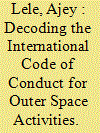

|
|
|
|
|
| Publication |
New Delhi, Pentagon security International, 2012.
|
| Description |
xxi, 190p.Hbk
|
| Standard Number |
9788182747005
|
|
|
|
|
|
|
|
|
|
|
|
Copies: C:2/I:0,R:0,Q:0
Circulation
| Accession# | Call# | Current Location | Status | Policy | Location |
| 056735 | 358.8/LEL 056735 | Main | On Shelf | General | |
| 056736 | 358.8/LEL 056736 | Main | On Shelf | General | |
|
|
|
|
| 19 |
ID:
126441
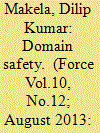

|
|
|
|
|
| Publication |
2012.
|
| Summary/Abstract |
The stage for the cyber war has already been set, albeit secretly. In the last two months, the revelations made by the US' ex-Central Intelligence Agency employee, Edward Snowden, in various interviews to The Guardian newspaper, revealed that the US' intelligence organisation, National Security Agency (which had launched the top-secret PRISM programme) was snooping on personal data of individuals and governments in the US and across the world through the internet. He also revealed that the National Security Agency (NSA) intercepted a big chunk of sensitive information that belongs to India by spying on the embassies and their diplomatic missions. And perhaps the most daunting revelation was that the information sharing between the intelligence agencies of various countries, such as the US and the UK, is already underway.
|
|
|
|
|
|
|
|
|
|
|
|
|
|
|
|
| 20 |
ID:
146967
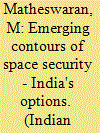

|
|
|
|
|
| Summary/Abstract |
Space has emerged as a critical centre of gravity. The use of space-derived inputs is a vital necessity for the conduct of everyday life on Earth. While civil and commercial space activities provide a range of applications, create employment, and promote technological progress, the use of space for military and intelligence purposes has become critical requirements for national security.
The fears of an arms race and power-politics for dominating space or establishing control and hegemony in space are very real. The emerging contours of space security are dominated by the contest between national security interests of states and the interests of the larger humanity. This contest is unlikely to ever end. In the meantime, India must preserve its freedom to access and exploit space for its security and development. Given rapid developments in technology and space capabilities, it is important that India steers itself into a position of strength in space, technologically, economically, and militarily, in order to support and usher 21st century space as a peaceful ‘Global Commons.”
|
|
|
|
|
|
|
|
|
|
|
|
|
|
|
|
|
|
|
|
|